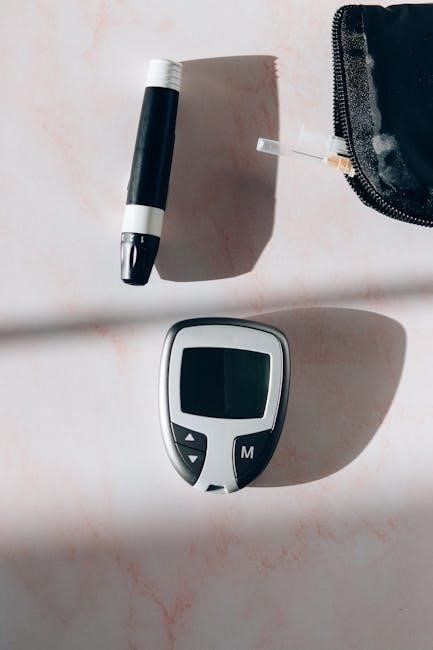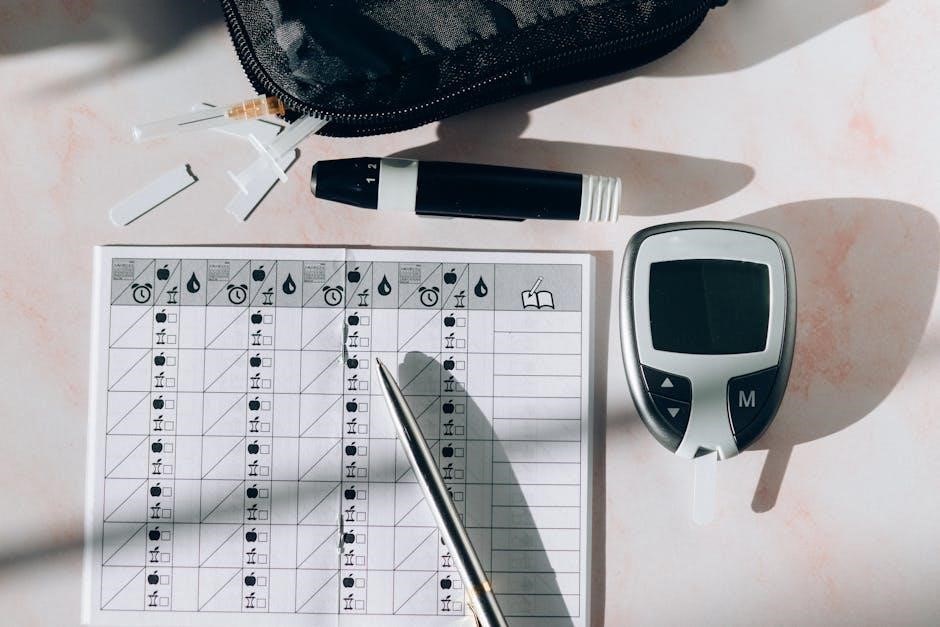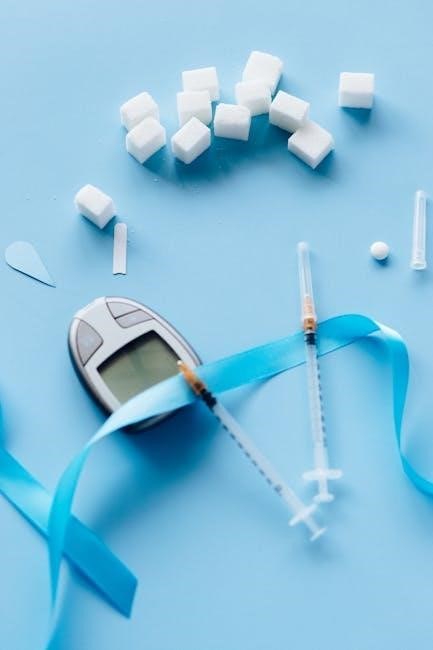Blood sugar logging is essential for managing diabetes. Using a weekly PDF log sheet helps track glucose levels‚ insulin doses‚ and meals‚ promoting better health outcomes and informed decisions easily.
Importance of Monitoring Blood Sugar Levels
Monitoring blood sugar levels is crucial for effective diabetes management. It provides insights into how diet‚ exercise‚ and medications impact glucose levels‚ helping to prevent spikes and drops. Regular tracking allows individuals to identify patterns and make informed decisions to maintain stable blood sugar; This practice is vital for preventing complications like hypoglycemia and hyperglycemia‚ which can lead to serious health issues if left unmanaged. By using tools like a weekly PDF log sheet‚ individuals can record their readings‚ insulin doses‚ and daily activities‚ creating a comprehensive overview of their condition. This data is invaluable for healthcare providers‚ enabling them to adjust treatment plans and improve outcomes. Consistent monitoring fosters better awareness and control‚ empowering individuals to take charge of their health proactively. Over time‚ this habit contributes to long-term wellness and reduces the risk of diabetes-related complications.
Benefits of Using a Weekly Blood Sugar Log Sheet
A weekly blood sugar log sheet offers numerous benefits for managing diabetes effectively. It allows individuals to track their glucose levels‚ insulin doses‚ and daily activities in one organized place. This tool helps identify patterns and trends in blood sugar fluctuations‚ enabling better decision-making. By monitoring meals‚ exercise‚ and stress‚ users can understand how these factors influence their glucose levels. The log sheet also serves as a visual record‚ making it easier to share information with healthcare providers. This collaboration can lead to more personalized and effective treatment plans. Additionally‚ using a weekly log sheet promotes consistency and accountability‚ which are key to maintaining stable blood sugar levels. Over time‚ this practice empowers individuals to take control of their diabetes‚ reducing the risk of complications and improving overall health outcomes. It’s a simple yet powerful tool for proactive health management.

How to Use a Weekly Blood Sugar Log Sheet
Record blood sugar levels‚ insulin doses‚ and meals daily. Track readings before meals‚ note insulin intake‚ and document daily activities to manage diabetes effectively for better health outcomes.
Steps to Download and Print a Free PDF Template

Visit trusted websites like Adobe Spark‚ PDFDrive‚ or the American Red Cross for free downloadable blood sugar log sheet templates.
Search for “weekly blood sugar log sheet PDF” to find suitable options.
Select the desired template and click the download button to save it.
Open the PDF using Adobe Acrobat Reader or similar software.
Print the template on standard paper for easy use.
Fill in the details daily‚ including blood sugar readings‚ insulin doses‚ and meals.
This tool helps track glucose levels and manage diabetes effectively.
How to Record Blood Sugar Readings Accurately
Recording blood sugar readings accurately is crucial for effective diabetes management. Use a reliable blood glucose meter and test strips‚ ensuring they are not expired or damaged. Test at consistent times‚ such as before meals‚ after meals‚ and at bedtime‚ as directed by your healthcare provider. Write down each reading immediately in your log sheet‚ noting the date and time. Include any additional factors that may affect your levels‚ such as physical activity‚ stress‚ or illness. Track insulin doses and carbohydrate intake alongside your readings for a comprehensive view. Be consistent with your logging schedule to identify patterns and trends. Review your log regularly with your healthcare provider to adjust your treatment plan as needed. Accurate and detailed records help you make informed decisions to maintain stable blood sugar levels and improve your overall health.
Tips for Maintaining Consistency in Logging

Maintaining consistency in blood sugar logging is key to effective diabetes management. Establish a daily routine‚ such as logging immediately after testing‚ to make it a habit. Keep your log sheet and blood glucose meter in the same location to avoid forgetting. Set reminders on your phone or place sticky notes in visible spots to ensure you never miss a reading. Record your levels and any relevant notes as soon as you test to prevent gaps in your data. Be consistent with the format of your entries to make reviewing easier. If you miss a reading‚ don’t skip logging it—note the omission and move forward. Finally‚ review your log weekly to identify patterns and stay motivated. Consistency ensures accurate insights‚ helping you manage your diabetes more effectively and make informed decisions about your health.

Key Elements of a Blood Sugar Log Sheet

- Blood sugar readings before and after meals
- Insulin doses and medication tracking
- Carbohydrate intake monitoring
- Notes section for exercise‚ stress‚ or other factors
Blood Sugar Readings Before and After Meals
Recording blood sugar levels before and after meals is crucial for understanding how your diet affects glucose levels. This data helps identify patterns‚ such as spikes after certain foods‚ and informs meal planning. By tracking pre-meal and post-meal readings‚ you can monitor how your body responds to carbohydrates and other nutrients. This information is vital for adjusting portion sizes‚ meal timing‚ and medication dosages. Many log sheets provide columns for both fasting and postprandial readings‚ allowing for a detailed analysis of daily fluctuations. Regularly reviewing these entries can help you make informed decisions to stabilize your blood sugar and maintain better overall health. Accurate and consistent tracking also enables healthcare providers to offer personalized advice tailored to your dietary and lifestyle habits.
Insulin Dose Tracking
Tracking insulin doses is a vital component of blood sugar management. A weekly PDF log sheet allows you to record the type‚ amount‚ and timing of insulin administered‚ helping you understand how it affects your glucose levels. This data is essential for identifying patterns and optimizing your insulin regimen. By documenting each dose‚ you can monitor how different factors‚ such as meals or physical activity‚ interact with your medication. This information enables healthcare providers to adjust your treatment plan for better blood sugar control. Many log sheets include dedicated sections for insulin tracking‚ making it easy to maintain accurate records. Regularly reviewing your insulin doses alongside blood sugar readings helps pinpoint areas for improvement and ensures your treatment remains effective. This practice is particularly useful for those requiring multiple daily injections or adjusting basal and bolus doses.

Carbohydrate Intake Monitoring
Carbohydrate intake monitoring is crucial for blood sugar control‚ as carbs have the most significant impact on glucose levels. A weekly PDF log sheet provides a dedicated space to track the amount and type of carbohydrates consumed at each meal and snack. This helps identify how specific foods affect blood sugar levels‚ enabling better meal planning and portion control. By documenting carbohydrate intake alongside blood sugar readings‚ individuals can spot patterns and make informed decisions to avoid spikes. Many log sheets include a section for carb counting‚ making it easier to manage diabetes effectively. Additionally‚ tracking carbs helps in balancing meals and ensures that dietary goals are met. This practice is especially beneficial for those using insulin or medications that are affected by carbohydrate intake. Regular monitoring of carbs can lead to improved blood sugar stability and overall health outcomes.
Notes Section for Additional Factors (Exercise‚ Stress‚ etc.)
The notes section in a weekly PDF blood sugar log sheet is vital for recording additional factors that influence blood sugar levels. Exercise‚ stress‚ sleep quality‚ and other lifestyle elements can significantly impact glucose readings. By documenting these factors‚ individuals can identify patterns and correlations‚ gaining a clearer understanding of what affects their blood sugar. For example‚ noting the type and duration of exercise can help explain post-workout glucose fluctuations. Similarly‚ recording stress levels or unusual events provides context for unexpected spikes or dips. This section also allows users to track medications‚ illnesses‚ or other variables. Consistently updating the notes section enhances the accuracy of blood sugar tracking and supports better decision-making. It serves as a comprehensive tool for managing diabetes holistically‚ ensuring that no factor goes unaccounted for in maintaining stable glucose levels. This feature makes the log sheet more than just a tracking tool—it becomes a personalized guide for better health.

Where to Find Free Printable Blood Sugar Log Sheets
Free printable blood sugar log sheets are widely available online. Popular sources include Google‚ Microsoft Office templates‚ and official diabetes websites like Diabetes.org. These templates are customizable and easy to download for comprehensive tracking.
Best Websites for Free PDF Downloads
Several websites offer free downloadable PDF templates for blood sugar logging. Google and Microsoft Office provide customizable templates that can be easily edited and printed. Additionally‚ Diabetes.org and other health-focused websites offer comprehensive log sheets tailored for diabetes management. These templates often include sections for blood sugar readings‚ insulin doses‚ and meal tracking. Many websites also provide editable PDFs that can be filled out digitally and saved for future reference. Some platforms even offer mobile-friendly versions‚ allowing users to track their blood sugar on-the-go. These resources are convenient‚ user-friendly‚ and designed to help individuals maintain consistent monitoring of their blood sugar levels. By utilizing these free templates‚ users can effectively manage their diabetes and make informed lifestyle choices. These tools are widely available and accessible‚ making blood sugar logging straightforward and efficient for everyone.
Using Microsoft Office or Google Docs Templates
Microsoft Office and Google Docs offer a variety of free‚ customizable templates for blood sugar logging. These templates are easy to download and can be tailored to suit individual needs. In Microsoft Excel or Google Sheets‚ users can create detailed logs with columns for blood sugar readings‚ insulin doses‚ and carbohydrate intake. Google Docs also provides editable PDF templates that can be shared and accessed across devices. These tools allow for real-time updates and seamless collaboration with healthcare providers. Additionally‚ both platforms offer pre-designed formats that simplify the logging process‚ ensuring consistency and accuracy. Users can also export their logs as PDFs for easy printing or sharing. These templates are ideal for individuals who prefer digital tracking but still want the flexibility to print their records when needed. They provide a convenient and organized way to monitor blood sugar levels effectively.
Mobile Apps for Digital Blood Sugar Tracking
Mobile apps provide a convenient and digital way to track blood sugar levels‚ complementing the use of weekly PDF log sheets. Apps like MySugr and Glucose Buddy allow users to log their blood sugar readings‚ carbohydrate intake‚ and insulin doses directly on their smartphones. These apps often sync with glucose meters‚ making data entry quick and accurate. Features such as real-time graphs and customizable reminders help users stay on top of their blood sugar management. Additionally‚ many apps offer cloud storage‚ ensuring data is accessible across devices. They also provide reports and insights to identify trends and patterns‚ which can be shared with healthcare providers. While printable PDF sheets are great for physical records‚ mobile apps add flexibility and convenience‚ especially for those who prefer digital tracking. They serve as a comprehensive tool for managing diabetes alongside traditional logging methods. This combination ensures consistent and accurate blood sugar monitoring.

Managing Blood Sugar Levels Effectively
Monitoring glucose levels‚ healthy eating‚ and regular physical activity are key to managing blood sugar effectively. Combining these habits with stress reduction techniques helps maintain stable blood sugar levels and overall well-being.
Dietary Tips to Control Blood Sugar Spikes
Controlling blood sugar spikes begins with a balanced diet. Focus on whole‚ unprocessed foods like vegetables‚ lean proteins‚ and whole grains‚ which digest slowly and prevent rapid glucose rises. Avoid sugary drinks and refined carbohydrates‚ as they cause sharp blood sugar increases. Incorporate fiber-rich foods‚ such as fruits‚ legumes‚ and nuts‚ to slow sugar absorption. Pair carbohydrates with protein or healthy fats to stabilize blood sugar levels. Practice portion control and use a carb calculator to track carbohydrate intake. Stay hydrated‚ as dehydration can elevate blood sugar levels. Plan meals in advance and use your weekly blood sugar log sheet to identify patterns and adjust your diet accordingly. By tracking and managing your food choices‚ you can better regulate blood sugar spikes and maintain overall health.
Exercise and Its Impact on Blood Sugar Levels
Exercise plays a crucial role in managing blood sugar levels. Regular physical activity helps lower blood sugar by increasing insulin sensitivity‚ allowing glucose to enter cells more efficiently. Aerobic exercises‚ such as walking or cycling‚ and strength training are highly effective. Even short bouts of activity can have a positive impact. However‚ intense or prolonged exercise may temporarily lower blood sugar‚ so monitoring levels before and after workouts is essential. Consistency is key‚ as irregular exercise can lead to unpredictable blood sugar fluctuations. Pairing exercise with a balanced diet and tracking patterns in your weekly blood sugar log sheet can help identify how activity affects your glucose levels. This data enables better planning and adjustments to maintain stable blood sugar levels and overall health.

Stress Management Techniques for Better Diabetes Control
Stress can significantly impact blood sugar levels by raising glucose and hindering insulin efficiency. Effective stress management is crucial for diabetes control. Techniques like deep breathing exercises‚ meditation‚ and yoga can help reduce stress and stabilize blood sugar. Regular physical activity‚ such as walking or stretching‚ also contributes to stress reduction while improving insulin sensitivity. Additionally‚ journaling or tracking stress levels in your weekly blood sugar log sheet can help identify patterns and triggers‚ enabling better management. Time management and prioritizing tasks can also alleviate stress. By incorporating these practices into your daily routine and monitoring their effects alongside blood sugar readings‚ you can achieve better overall diabetes control and improve your quality of life. Consistent stress management‚ combined with proper logging‚ supports long-term health and well-being for individuals with diabetes.
